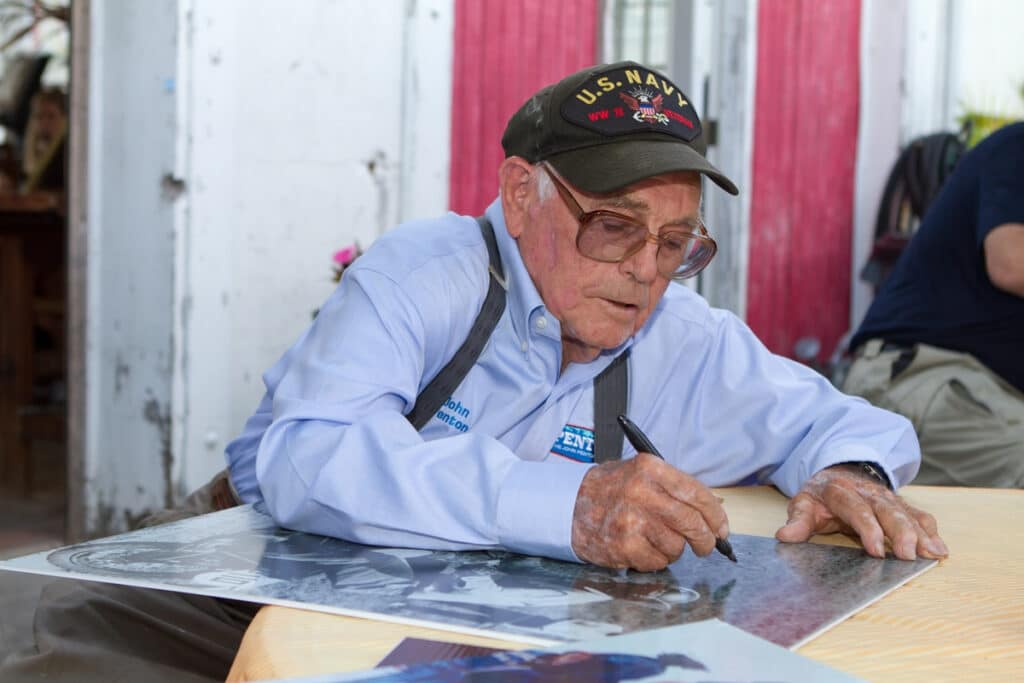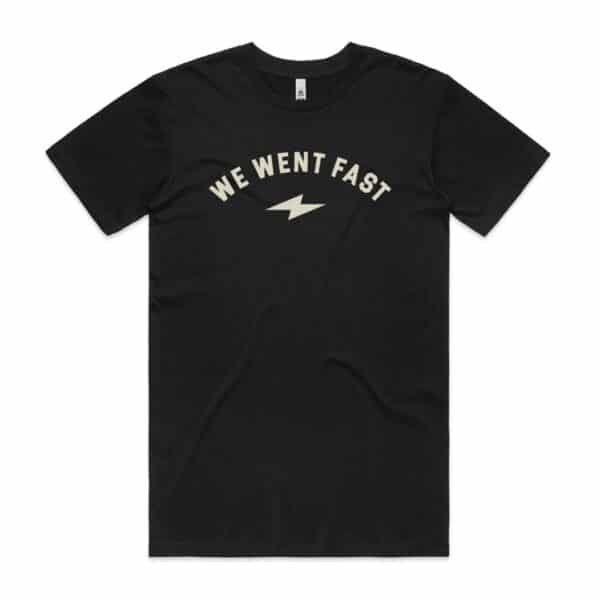John Penton Was in a Hurry
By
The search for deeper meaning in Penton’s 1959 record-breaking transcontinental ride.
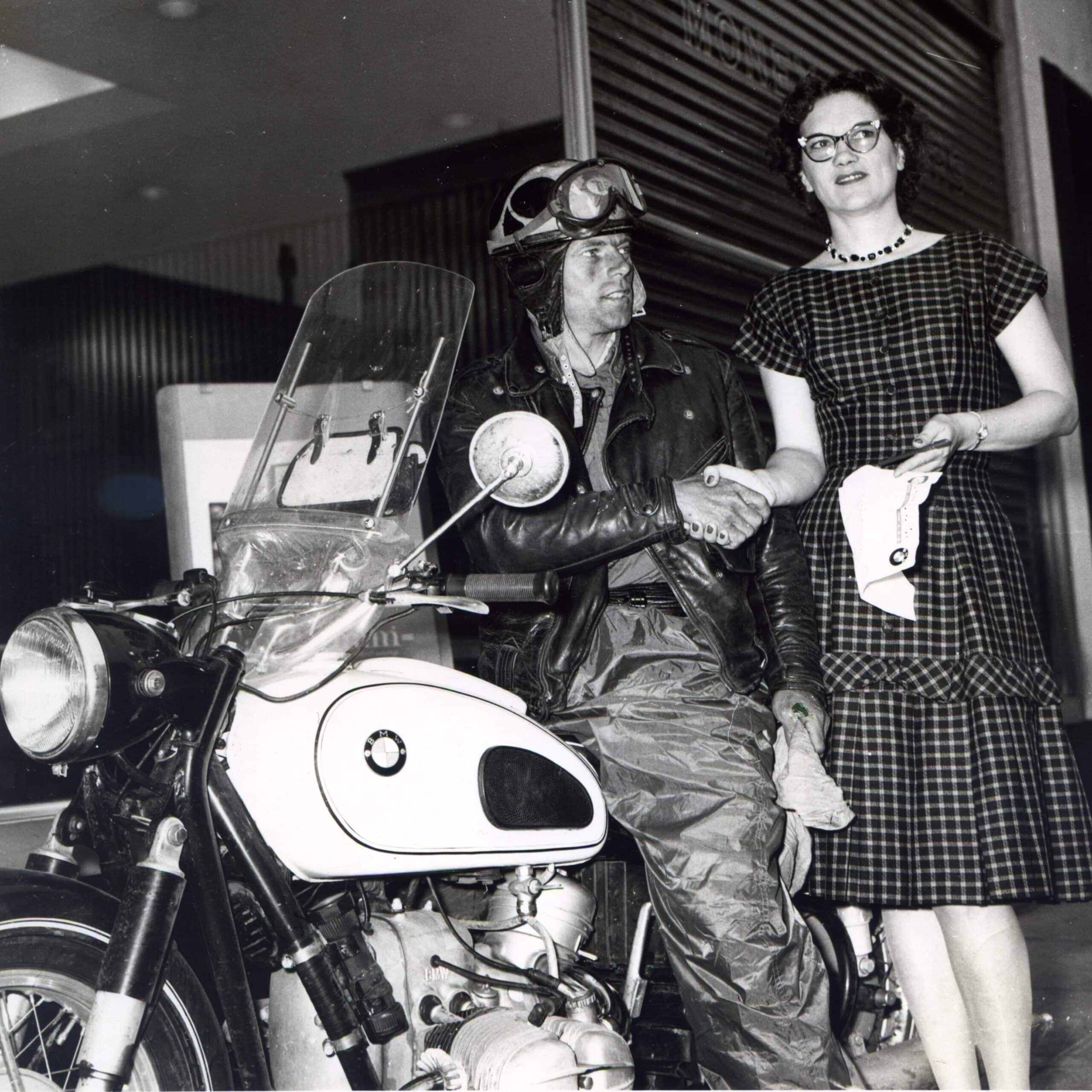
Reporting for this essay happened in 2015.
John Penton opens his front door with a slight look of confusion on his face; he knows about the scheduled visit but he’s still clearly puzzled why a young man from Baltimore drove 400 miles to Amherst, OH to chat. Now 90, Penton’s peak height of 5-ft. 5-in. has been rounded off with age; the once athletic build he had as one of the greatest motorcycle racers of his era is gone, now immortalized in the engravings of the plaques and trophies that bear his name and in the book and movie about his life, both created by other men who admired him.
Penton has never asked for any of this attention and it still makes him chuckle that people continue to find his life interesting.
Wearing a long sleeved Husaberg t-shirt with tatters and holes from more than two decades of use, and black suspenders that hold up green cargo shorts, he turns and waves me inside to a small kitchen table that has room for three. His wife, Donna washes the dishes from breakfast and John sits and shuffles a stack of papers.
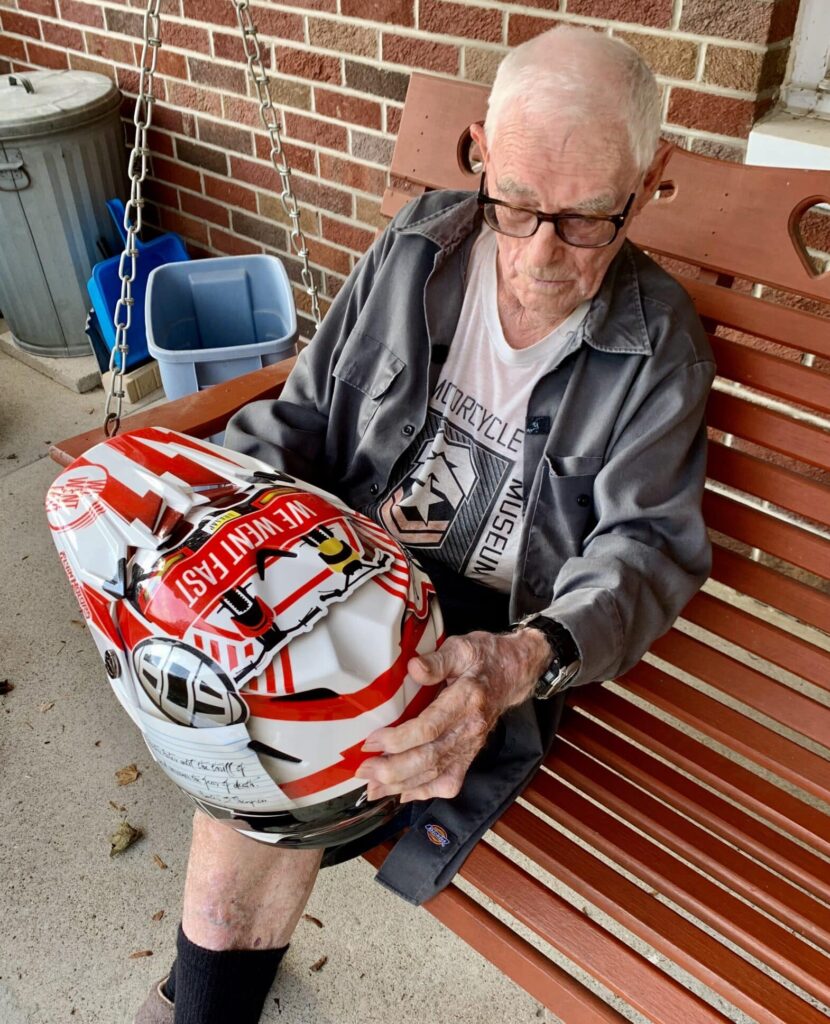
The tick-tock of the grandfather clocks in the house fills the dead space while Penton waits for me to explain why I’m here. Of all the deals, victories, awards and milestones that made him an international motorcycle industry legend, I only want to talk about one; of the nearly 33,000 days John Alfred Penton has been alive I’m here to discuss slightly more than two: the 52 hours, 11 minutes and one second of his life he spent riding from New York City to Los Angeles in early June 1959.
That transcontinental ride, which annihilated the existing record by more than 25 hours, has always seemed like an incompletely told story. It was one page in his biography and a few minutes in a movie over two hours in length. He laughs, tilts his head back and says, “Oh, my…”
Get Some Fast
“The little incidences that naturally happened along the way, so many of them are gone,” Penton says after several moments of pause. But then he immediately jumps to the end of the ride, to a moment on Route 66 west of Needles, CA. “I never saw [Earl] Flanders. In fact, I never knew he was following me until he did catch me up.”
At the time, very few people knew Penton was attempting the record, only his brothers and Al Bondy, the U.S. BMW distributor with whom he’d stayed the night in New York before his departure.
Flanders, the western BMW distributor, got a call from Bondy and waited for Penton in the Mojave Desert west of Needles to help guide him through Los Angeles to the Western Union office where his time was recorded. A photographer took photos, the news went out on the AP and UP wires and soon the entire world knew the name John Penton.
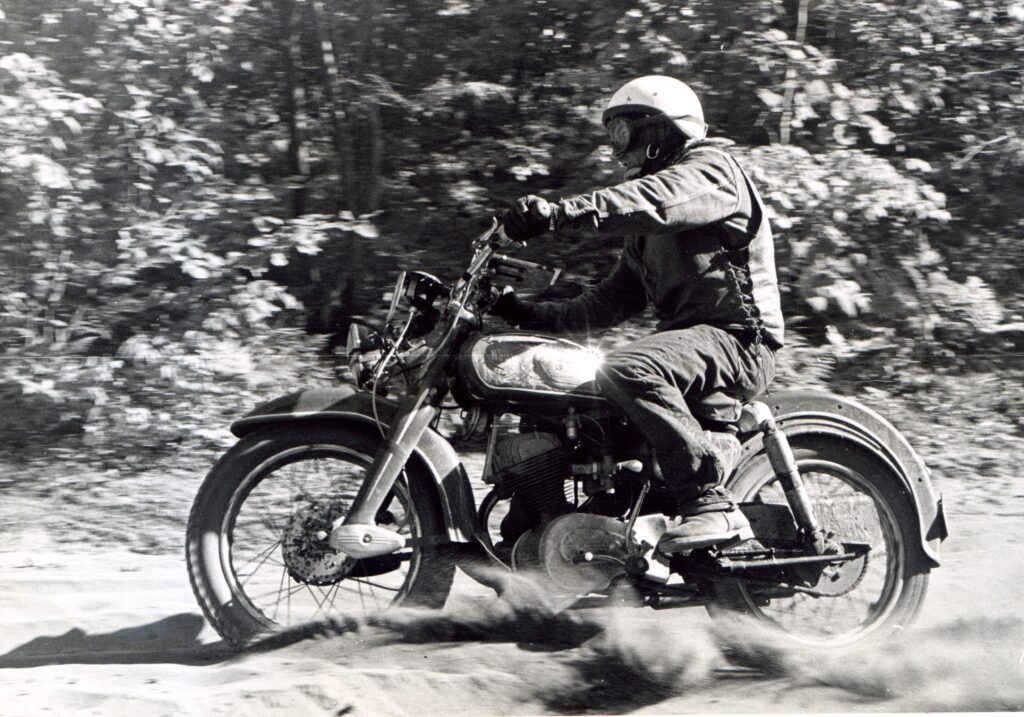
The First Transcontinental Racers
The first person to cross the United States on a motorized vehicle was George Wyman in 1903. Riding a California Moto Bicycle, he spent 50 days traveling from San Francisco to New York. “The Bicycling World and Motorcycle Review” reported on his progress and “The Motorcycle Magazine” contracted him to write five articles about his journey.
The most famous name associated with transcontinental rides, and whom the term “Cannonball Run” is named after, is Erwin Baker, who set dozens of long-distance records, including a motorcycle ride across the country – San Diego to New York – in 11 days, 12 hours and 10 minutes in 1914.

Like Wyman, he wrote about his own journey in a 10-page detail-rich article for “Motorcycle Illustrated”; in the desert he put a pebble beneath his tongue to keep him from wanting to exhaust his water supply, ran out of gas in Arizona and carried a .38 caliber gun, which he used to kill the animals that attacked him.
John Penton’s Inspiration
In 1958, after spending a month on his bike, soul searching in Mexico following the death of his first wife, Katherine, Penton concluded that journey with a straight shot ride from LA to Amherst, stopping only for fuel. His older brother Ted encouraged him to try to beat Earl Robinson’s transcontinental record of 77 hours 53 minutes, which had stood since 1935.
John liked the idea of the challenge and also because they thought it could help them sell more motorcycles at the family dealership. Proving that one of their brands could reliably cross the country would be good for business. “My brothers played a big part in my mind,” Penton says. “They always encouraged me forward. They had lots of faith in me.”
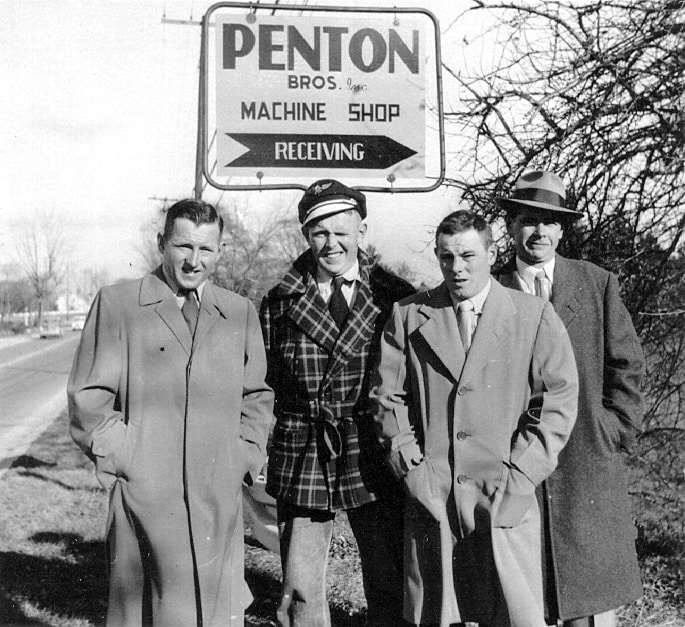
Penton trained for the ride by slipping through a hole in the fence of the Ohio Turnpike and running end to end through the night. Tim Masterson, who has crossed the country 25 times, rides at least 50,000 miles a year and is the president of the Wyman Memorial Project, says long distance riders call it ‘extending their riding horizon.’
“People ask me how I can ride 1500 miles at a time,” Masterson said. “One gas tank at a time. Each time you reach for a challenge, it’s always wrought with uncertainty.” Like ultra marathoners and other long distance athletes, long distances riders (LDR) see what they do as a physical challenge to conquer. “It’s the experience of the ride and not the destination or things along the way,” he said. “It’s all about riding the bike.”
Penton’s riding horizon was already built up through all the miles he spent in the saddle traveling to the major enduro races, competing on the same bike – a German-built NSU – then riding it home. He also realized his knack for LDR in the weeks he spent riding and mourning the loss of his young wife. By the time he rolled away from the New York Western Union office on Broadway and into the Lincoln Tunnel at 5:59 a.m. on June 8, 1959, Penton was more than ready to cross the country in one sleepless dash.

Although he admits today that he had no set time or goal, interviews given to Cycle Magazine indicate that he was shooting for 54 hours. Riding a 600cc, 35 horsepower BMW R69 with two small modifications – a six-gallon fuel tank and a fender rack – the 33-year-old rode across the newly built turnpikes of the eastern United States.
He remembers waving to his brothers who were on the side of the Ohio Turnpike near Amherst and vividly recalls the moment he saw flashing lights coming into St. Louis. Word was passed from New York; a motorcycle dealer in St. Louis arranged for a group–which included two police officers–to help guide him through the city. They handed him two ham sandwiches and two cups of milk, without stopping.
At the turnpike tollbooths he hurriedly asked the operators to stamp his letter to further legitimize his run; with the gas station attendants he was short in conversation.
“As I went across the country those stops were so brief,” Penton says. “As I would leave I’m sure those people wondered, ‘What’s wrong with that guy?’”
In Oklahoma, he encountered 200 miles of driving rain and strong winds and 110 degree heat in Amarillo, TX but, overall, he remembers the weather being exceptional.
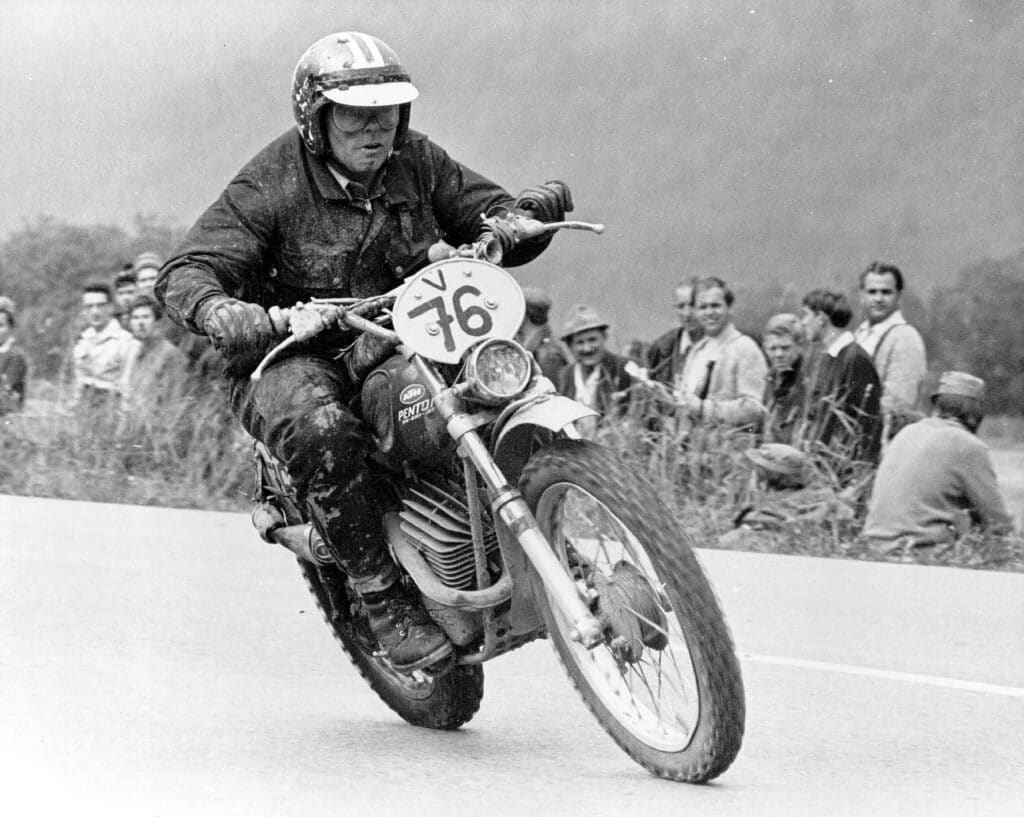
The only ‘blemish’ of the run was a rest stop near Flagstaff, AZ, about 500 miles from LA. The road was blacktop, it was night, and Penton was seeing double.
“Those lines were getting closer and closer together and I was getting into trouble,” he says. He stopped, set two alarm clocks, and shut his eyes for 45 minutes.
At 8:10 a.m. on June 10, still wearing his rain pants from the Oklahoma showers, Penton stopped in front of the Western Union office in downtown LA to record his official time: 3,051 miles in 52 hours 11 minutes and one second, traveling at an average speed of 58 miles per hour.
“Motorcyclist Magazine” reported that very little fanfare greeted Penton. He handed his tattered and stamp-filled letter to Miss Jeanon Smith, a Western Union employee, and posed for the camera of George O’Day of the “Los Angeles Herald-Press”. He gave reporters a few quips: “Some people like to climb mountains” and “Just for kicks,” when asked why he rode across the country so quickly.
Some people like to climb mountains.
–John Penton
After 12 hours of sleep, he met with Floyd Clymer, publisher of “Cycle” and a future fellow AMA Motorcycle Hall of Fame member, attended flat track races at Ascot Speedway and was introduced by announcer Roxy Rockwood. There he met Rodger Ward, who had recently won his first of two Indianapolis 500 races.
“That must have been a lot tougher ride than my 500 miles,” Ward told Penton. After visiting friends in Riverside, Penton rode home and moved on to the next challenge, which was try to earn a gold medal at the International Six Days Enduro, regrettably, the one racing goal he never achieved.
Nine years later Tibor Sarossy, a 22-year-old Hungarian bought a BMW from Penton’s dealership and rode from NY to LA in 45 hours 41 minutes. With more Interstate options Sarossy’s ride was 2,687 miles, nearly 400 miles less than Penton’s. The details of his ride were documented in a “Cycle World” feature in Dec. 1968. By that point, Penton was importing motorcycles with his own last name emblazoned on the gas tank.
The Search for More.
I naïvely believed that there was unpublished information to be gleaned from Penton himself, that maybe the many (and more knowledgeable and talented) historians before me didn’t ask the right questions or didn’t read his journal from the ride. Penton didn’t keep one; he wrote nothing down, which was the exact opposite of his younger sister, Patricia Penton Leimbach, a member of the Ohio Agriculture Hall of Fame, who wrote a column for the “Chronicle Telegram” for 40 years and three books, which all contained private details of her life.
For John, when one challenge finished he looked for the next. “I rushed all my life,” he says. “That’s what I did.” When asked why, he tries to explain but after a few minutes concludes with, “I can’t answer that question. I don’t know why.”
I rushed all my life. That’s what I did.
–John Penton
I came to Amherst to talk about a single motorcycle ride but the conversation often veered into World War II where Penton crossed the Atlantic Ocean three times with the Merchant Marines and risked the wrath of German U-boats; he watched ships go down, rescued soldiers from the Mediterranean Sea (including former schoolmate Mack Mackenzie!) and sailed to Okinawa and Korea in the Navy where he waited for the defeated Japanese to leave Seoul.
We even wandered into a discussion about what he believes to be the most revolutionary product in off-road motorcycling history: the o-ring chain.
Never mind the fact that it was Penton who introduced the small displacement off-road motorcycle to the U.S. market in the form of a 125cc, 15.5 horsepower, 185-lb. two stroke called the Penton.
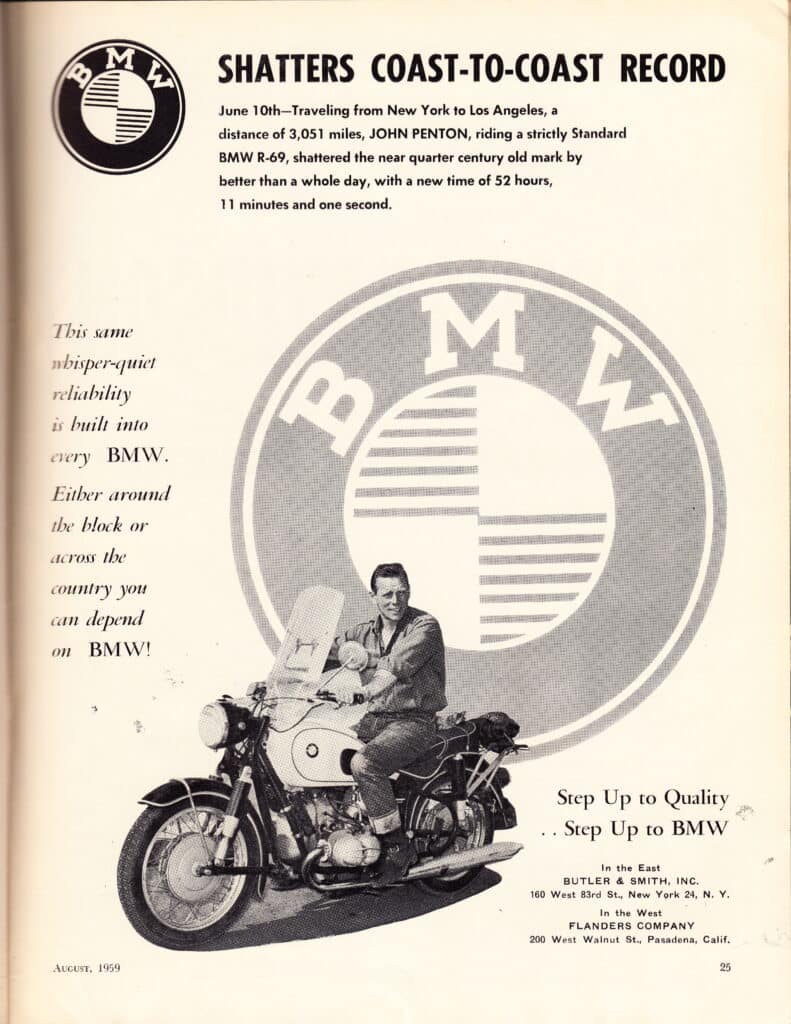
Nope, he’s more fascinated in how riders today can race for a week in the ISDE and not swap a chain. “They don’t even have to think about it!” he exclaims. The chain conversation then causes him to bring up a product he feels stupid about not having invented himself: hand guards. “Look at these hands!” he says, holding up his wrinkly and bumpy nonagenarian paws. The knobby knuckles and deep purple lines tell stories of the many trees that were unfortunate enough to be in the path of one of his motorcycles.
And then, after three hours of discussions that weaved in and out of the transcontinental ride, it’s obvious that time has stolen the rest of the details.
Penton’s life is so full, the transcontinental ride is somewhat of a footnote. It’s almost as if he’s being asked to recount the details of a decades-gone trip to the grocery store.
He leans forward to examine a piece of paper on the table before him. He looks up at the reporter.
“I have a tax problem that I have to take care of today,” he says.
And that’s it. The next challenge, while minor, waits at the Lorain County Courthouse and John Penton rushes off to face it.
